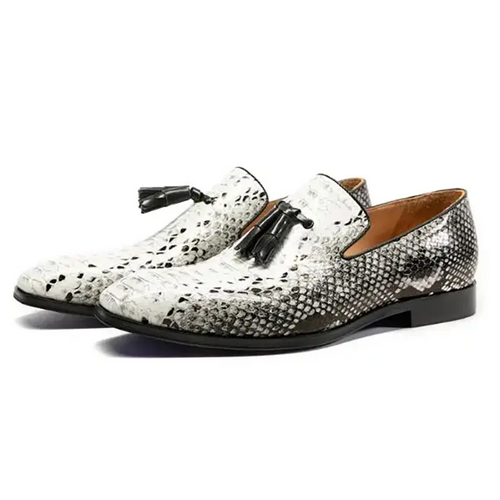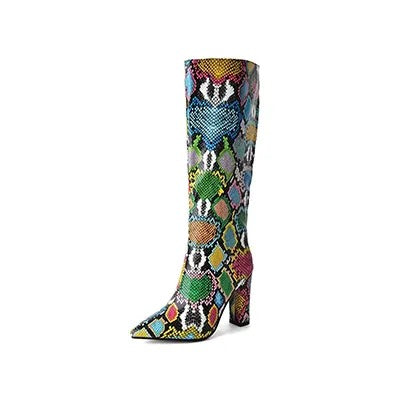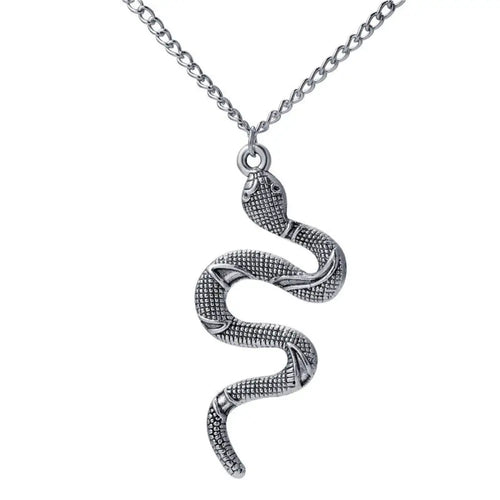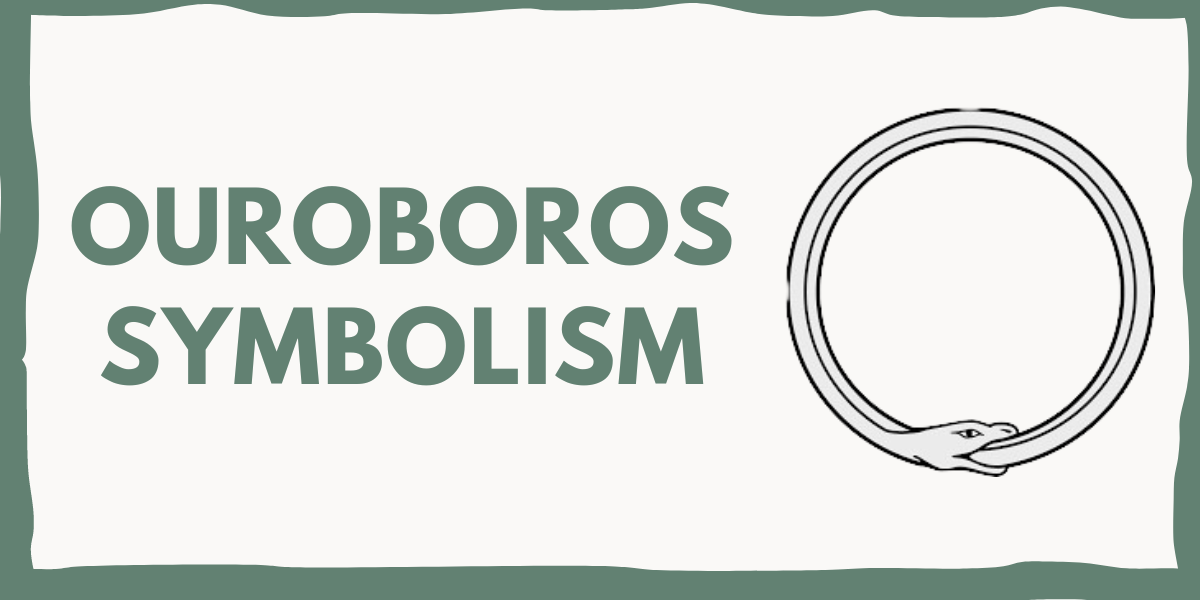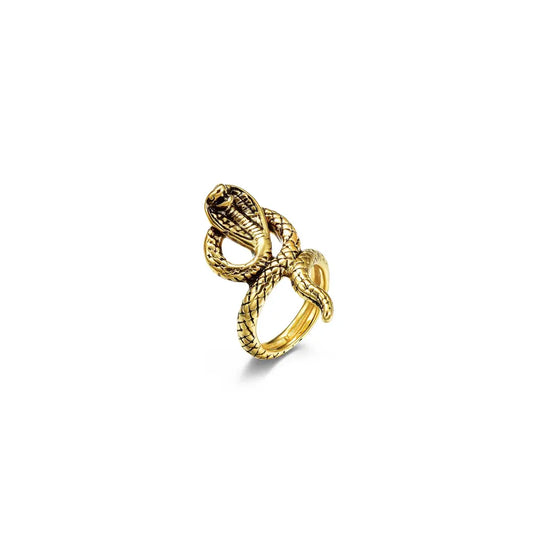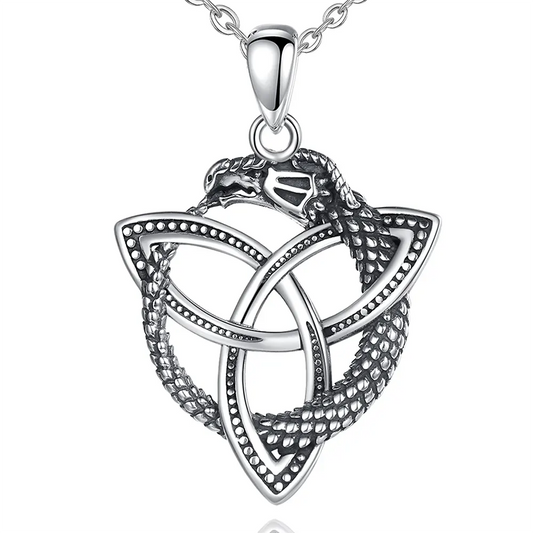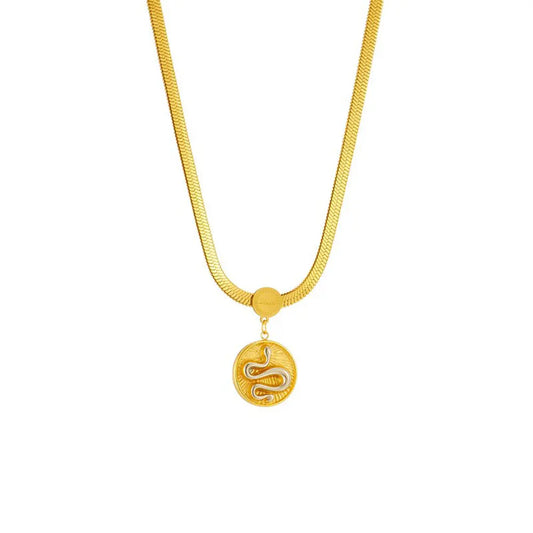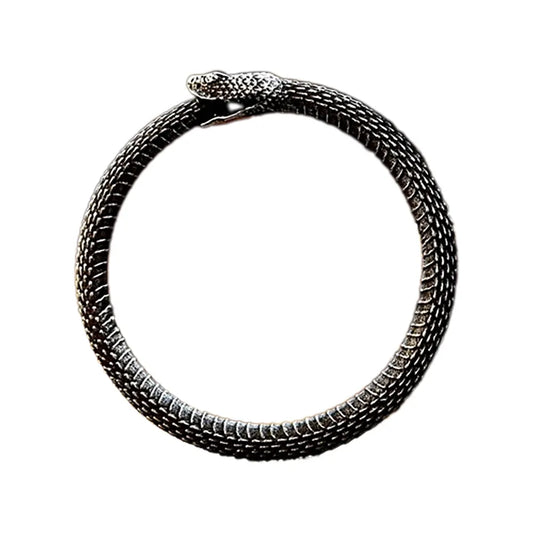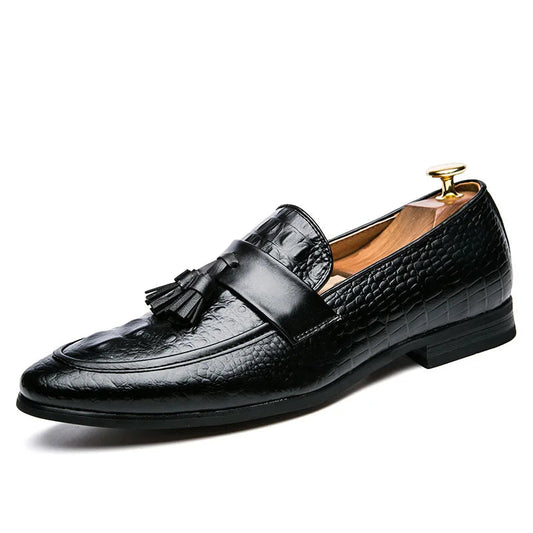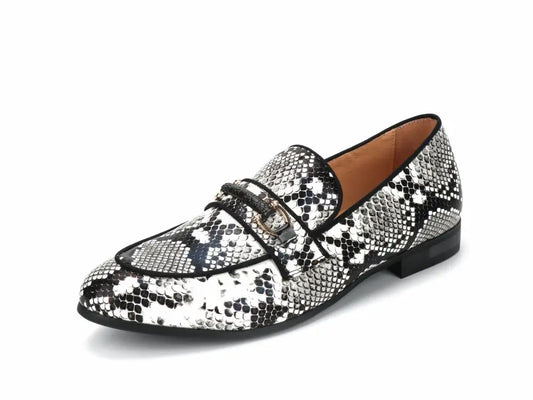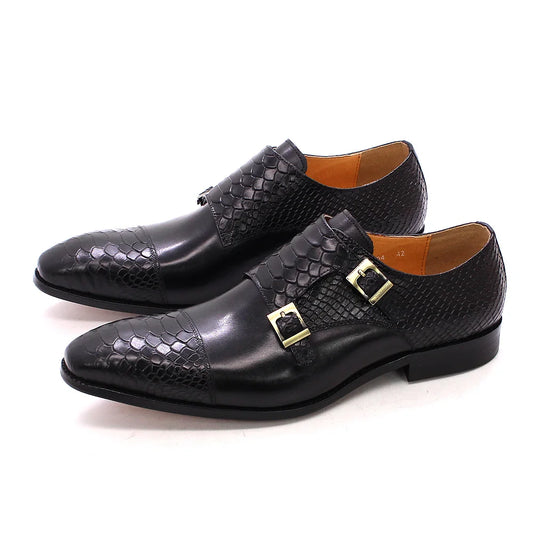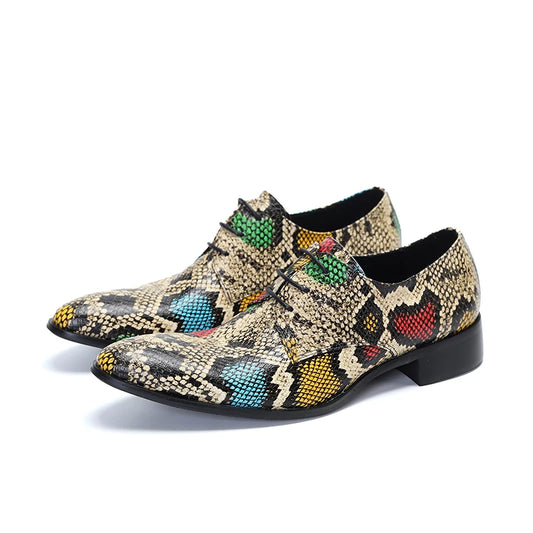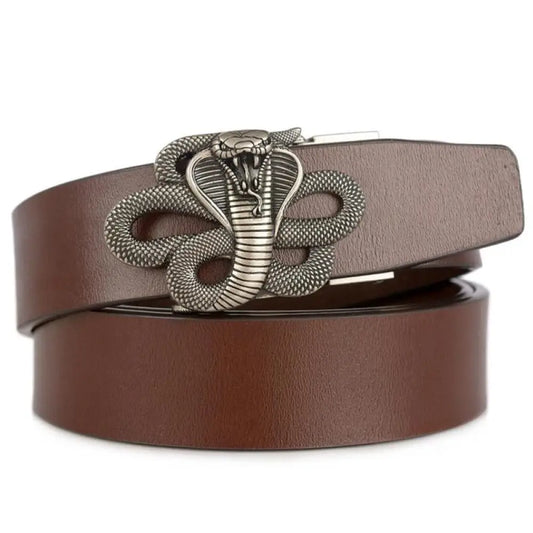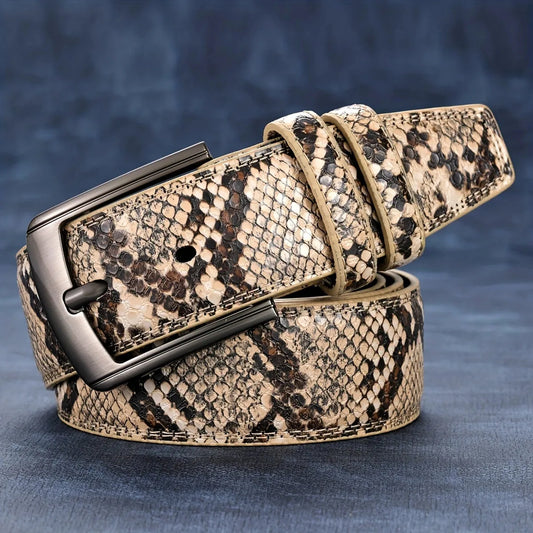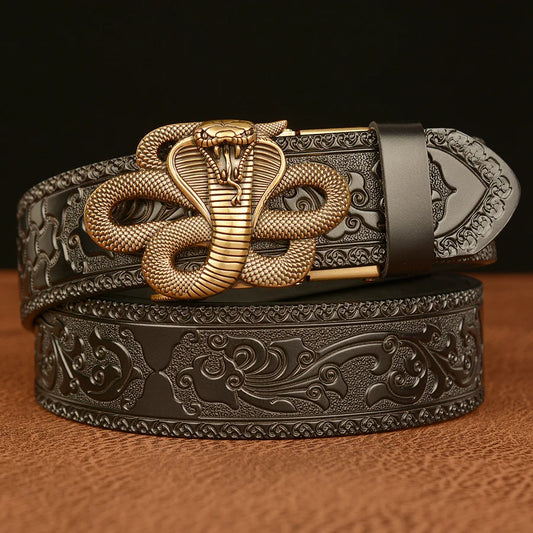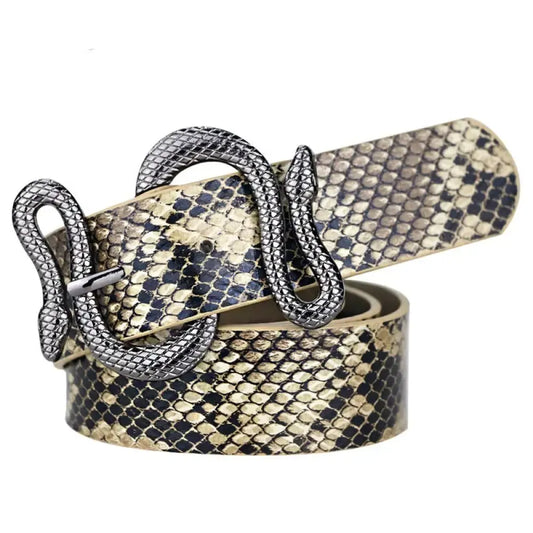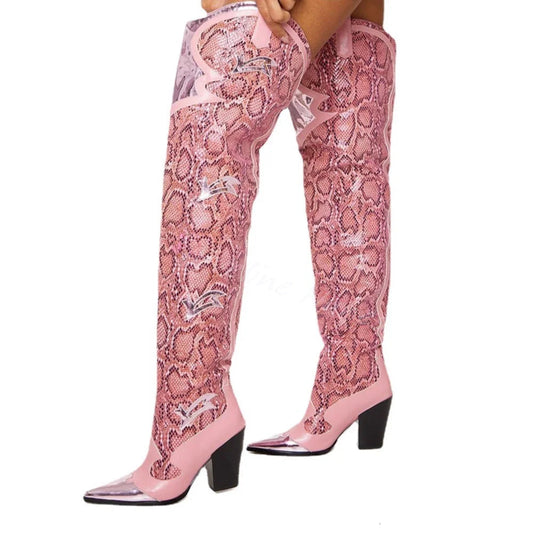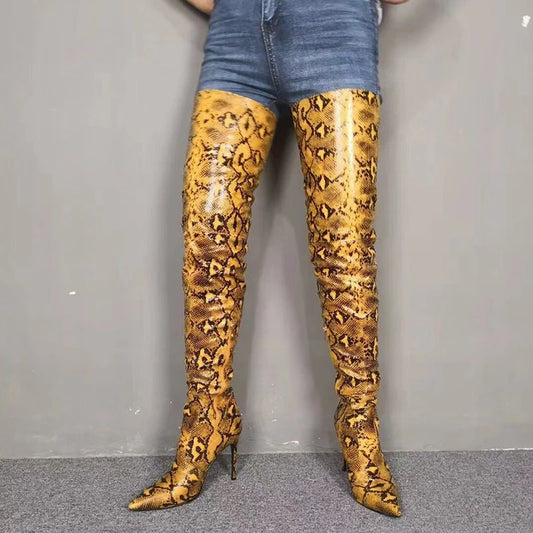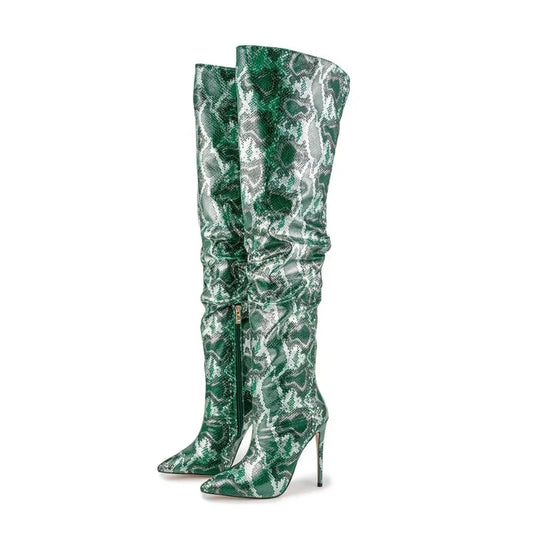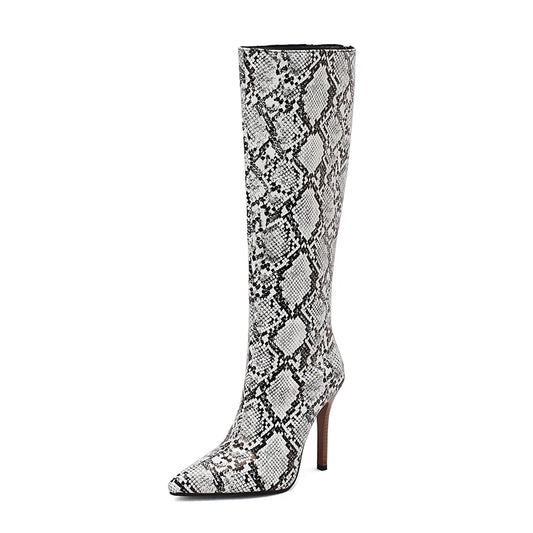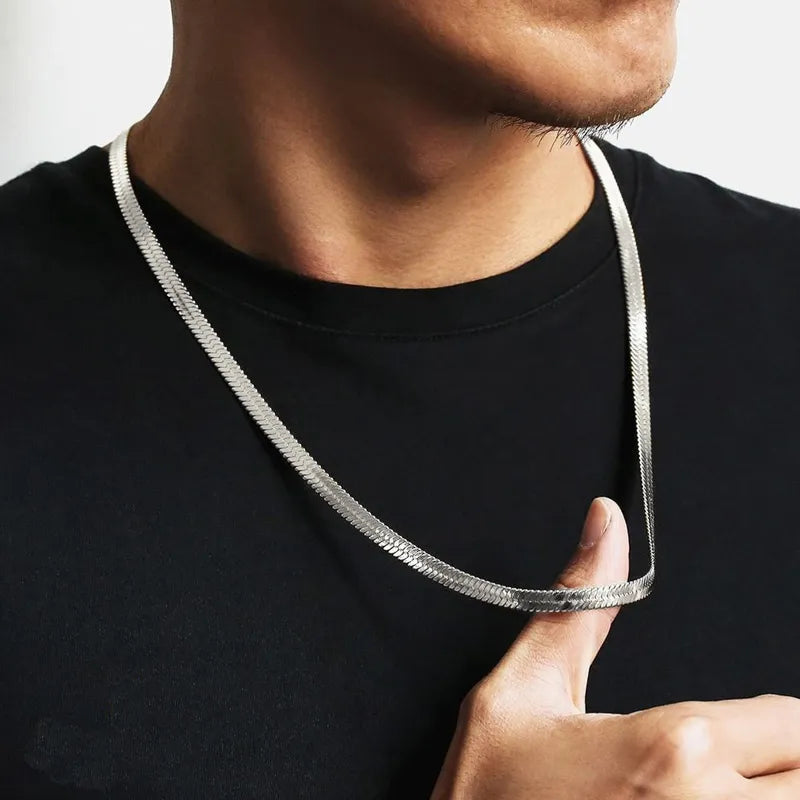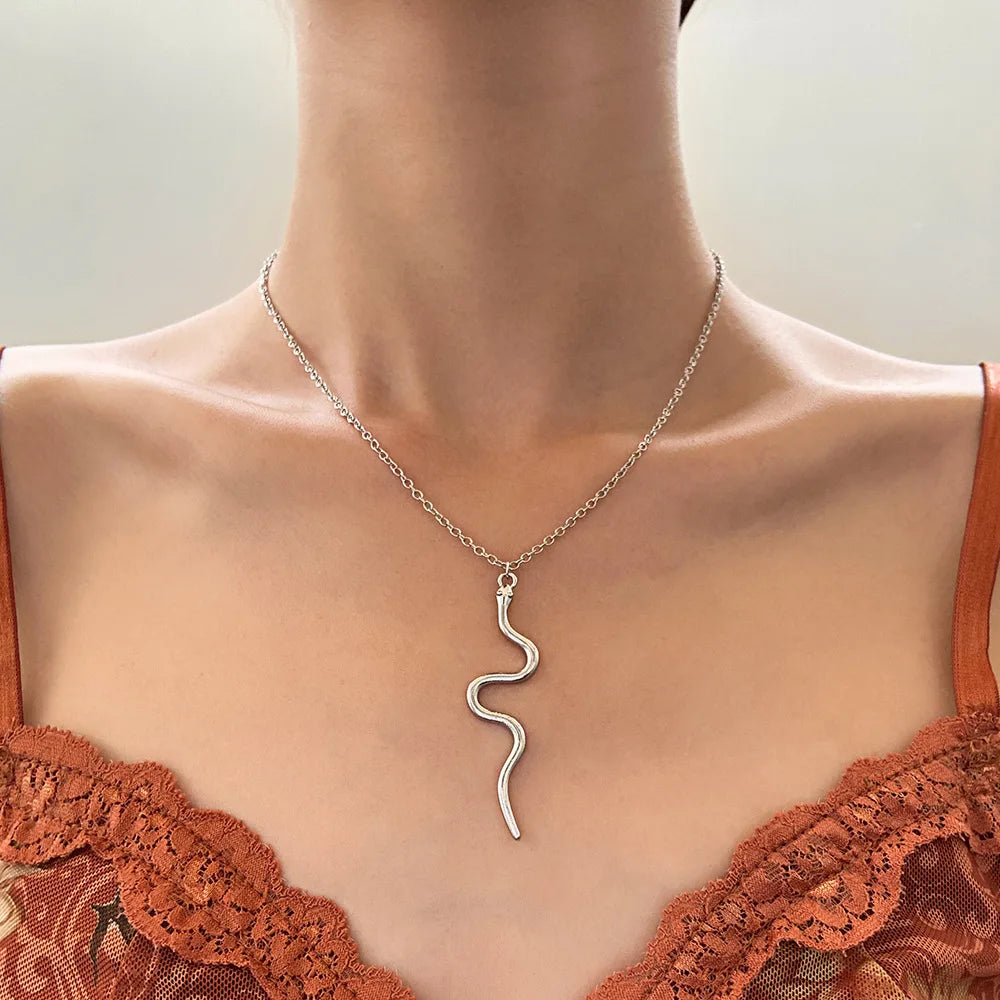Snakes exist in many ancestral cultures. Among all animals, it is the one with the most advanced symbolism . This designation is due to the snake's ability to molt, which symbolizes the rebirth of the body and soul.
But there is one snake that stands out above all others in terms of fame and meaning. He is so famous that if you go back in time to show an image of him to an Egyptian or an Aztec, he would recognize him immediately!
This legendary founding snake is the Ouroboros.
The Ouroboros is a representation of the snake that bites its tail. It symbolizes infinity, revival, and youthfulness. It also has a link to the stars. It is often representing the Milky Way. Circular in shape, it encompasses our world.
In this article, we propose a complete tour of the symbol of Ouroboros and its mysteries: from its origins 📖 to its application in alchemy and psychology.

1. THE OUROBOROS SNAKE
The Ouroboros depicts a snake biting its tail. In ancient Greek, this expression comes from the word "oura," which means tail and "Boros" for "to eat."
This representation illustrating the circular shape of a snake is one of the most famous and ancient symbols in the world. A Lemniscate sometimes represents it ♾️. It refers to philosophical, spiritual, and mythological notions.
This reptile is found in different civilizations around the planet. In particular, in alchemy and Gnosticism.

2. OUROBOROS: ITS MEANING
A. THE SERPENT OF ETERNITY
This mythological serpent has many meanings. The fact that it eats its tail symbolizes the eternal return of the universe: life and death, destruction, and creation. Ouroboros eats its tail infinitely, an eternal cycle symbolizing renewal �?. Finally, it symbolizes eternity and perpetual change.
This symbol belongs to the ideology that existence is like a cycle of constant rebirth. Therefore there is no death �?�️❌. This is why there is a link with the cyclical nature of time: the future devours the present to create a kind of infinite chain of moments that die and reborn at every moment.

B. OUROBOROS AND INFINITY
In many cults, the Ouroboros represents reincarnation. Other interpretations can be attached to this serpent. The self-sufficiency of nature, the rebirth of the earth, the ending, and the repetition of history are also part of the symbolism of this mythical snake.
It is also a mathematical symbol. The lemniscate is introduced in 1665 by John Willis this inverted eight or lazy eight symbolizes infinity for mathematicians. The double-loop representations showing the image of a snake eating its tail is also found in art 🖼️ and fantastic literature.

C. OUROBOROS SYMBOL OF BALANCE OF THE UNIVERSE
The Ouroboros is similar to Chinese Yin and Yang. It represents a powerful symbolic reflecting the equilibrium of the opposing forces—good and evil, fire and water, light and darkness. Our world has been built in this way. An excellent example is Heaven and earth, and man and woman. Each opposition has a value. That's why they can be united.
In many civilizations, the Ouroboros has played an important part in religious and mythological symbolism. But it has also been frequently used in alchemical illustrations ⚗️, where it symbolizes the circular nature of the alchemist's work. Its meaning is also often associated with Gnosticism and Hermeticism.
In summary, the meanings of Ouroboros can be summarized with the following concepts:
- Time,
- Continuity of life,
- Achievement,
- Repetition of the story,
- Self-sufficiency of nature,
- And the rebirth of the Earth.

3. ORIGINS OF OUROBOROS
Inspired by the ancestral Chinese Yin Yang, Ouroboros finds its first rise in ancient Egypt's iconographies. It is then spread in the West, then in the World, through the "Magic" field.
Indeed, it spread in Ancient Greece, then in various mythologies of Europe and the World.
In Ancient Greece, the Ouroboros is a symbol found in Gnosticism (all the doctrines of Gnosis of the first centuries of Christianity) and Hermeticism.
Hermeticism breaks down into two streams of thought:
- An esoteric doctrine based on manuscripts of Classical Antiquity,
- Growth in the field of Medieval alchemy, then mainly during the Renaissance. Moreover, it is mostly in alchemy that Ouroboros flourished.
A. TUTANKHAMUN'S OUROBOROS
The oldest evidence of a snake biting its tail that we have found to this day was in Egypt in 1600 BC. From there, it would have passed to the Phoenicians and then to the Greeks, who gave it its name: Ouroboros. The oldest symbol of Ouroboros appears on a golden shrine in the tomb of Tutankhamun ⚰️: It was found in the hieroglyphs that were in the Pharaoh's sarcophagus. The mythical serpent encircled the feet and head of the Pharaoh, symbolizing his status as an eternal deity in the afterlife.
B. THE WORLD SERPENT
This serpent influenced entire societies. Sometimes it represents a snake and other times a dragon, depending on the beliefs of the country. This symbol was seen during ancient Egypt, Aztec temples, Native American Indian tribes, Greek alchemical texts, in India and Japan, and even in woodcuts in Europe. It has even been connected to the Chinese Yin Yang and the biblical serpent in the Garden of Eden.
4. OUROBOROS IN MYTHOLOGY
The fascinating characteristic of Ouroboros is that it has been present in many people's cultures and mythologies . Sometimes, even peoples who had no connection with each other, or who lived at different times!
A. THE OUROBOROS IN EGYPT: THE ATUM SNAKE
Ouroboros can be found until ancient Egypt, around 1600 B.C. It appears in the Egyptian Book of the Other World (or Book of the Dead 💀). Ouroboros was popular after the Amarna period.
In this Book of the Dead, it is said that the sun god Atum, came out of the waters of chaos with a serpent. The animal was immortal because it "renewed" itself every morning. As such, the Ouroboros, in its original Egyptian context, symbolized repetition, renewal, the eternal cycle of time, sometimes even the sun.
Instead of something linear and evolving. The ancient Egyptians saw time as a repeating cycle. This is called the "mystery of cyclic time" or Neheh. The Neheh corresponds to the imperfect aspect of time, the never-ending cyclical movement, the constant return of days, months, years, and other longer cycles, such as the gap between the Egyptian calendar and the solar calendar, which is canceled only every 1,460 years.
The famous drawing of the Ouroboros also appears in the alchemical text The Chrysopoeia, by "Cleopatra the Alchemist" (an Egyptian, different from the queen goddess Cleopatra). It is an ancient treatise on alchemy dating from the 2nd century in Alexandria, which deals with the subject of the Philosopher's Stone 💎. We will come back to this point.
B. THE GREEK OUROBOROS: THE PRIMORDIAL CREATURE
Plato described a circular, self-eating beast as the first divine creature in the universe 🥇. Because he was alone in the cosmos, this primordial creature had a few characteristics:
- He didn't have eyes because there was nothing to see outside of him.
- No ears because there was nothing to hear.
- No lungs because there was no atmosphere to breathe.
- No organs, because there was no food and no water
- No members because there was nowhere to go, no one to defend against, and nothing to catch.

The Ouroboros was born in this way, all alone in the cosmos. The Alpha and the Omega of the Universe, the beginning and the end of all things.
The creators have given it a spherical shape so that it can make a circular movement on itself infinitely. The Greek Ouroboros symbolized eternity and the soul of the world.
In Greek mythology, it is also seen as a representation of natural forces. The Moon, the waves of the oceans, the sun, etc...
There is a connection with the myth of Sisyphus. In this legend, Sisyphus is condemned to push a rock down a steep slope. But once at the top of the slope, the rock falls back down the hill, and so Sisyphus has to restart his efforts and repeat the task for the eternity!
Unlike common belief, the Aesculapian snake wrapped around the caduceus of Hermes is not related to the symbol of the Ouroboros but symbolizes commerce. Similarly, for the Staff of Asclepius, a symbol of medicine.
C. VIKING OUROBOROS: JORMUNGAND
Ouroboros also appears in Scandinavian culture. The Jörmungand Serpent (or Jormungandr) is one of the three children of Loki and Angrboda. This monster of titanic proportions is so large that it can encircle Midgard, the world of mortals, and grasp its tail between its teeth . It also guards the Tree of Life and is often represented as an Ouroboros.
According to legend, when Jormungandr drops his tail, he will come to destroy the world during Ragnarok. This will mean the end of the world.
The God of thunder, Thor, fought against the giant snake, but he couldn't kill it.
In the legends of Ragnar Lothbrok, Ragnarsson, the king of Geatish Hero, gives a gift to his daughter Pora Town-Hart . The king then turns into a large snake that surrounds the girl's tent and bites its tail. The serpent is killed by Ragnar, who marries Pora. Later, Ragnar will have a son with another woman named Kraka. This son was born with the shape of a white snake biting its tail in one of his eyes. This baby with a snake encircling one of his irises is named Sigurd Snake-in-the-Eye.
D. THE CHINESE OUROBOROS: A DRAGON?
In Chinese culture, the Ouroboros is more related to Yin Yang. This very popular Asian symbol represents the connection of opposing forces. They believe that the universe is a perfect combination of opposites. For example, the division between the heavens (above) and the earth (below). They are opposed but united! Each opposite is powerful, but their union is even more powerful. For the creation of the universe, creators imagined the reproduction to conceive new things. Today, reproduction results in the union of two opposites: man 👨 and woman 👩.
The Chinese perceived light as Yin and darkness as Yang as ideal opposites. When they were united, they produced creative energy.
The Yin-Yang symbol was probably transformed into a symbol called Ouroboros when Chinese alchemy reached Alexandria 🗺️. It is a serpent that symbolizes the soul. His head and anterior part are clear like the soul. His tail and hind part are dark, representing the body. The soul and the body being two opposites uniting to make a unit: Man.
Ouroboros is represented here in black and white. It is the cosmic soul, the source of all creation. We find this symbolism of something similar to the Ouroboros in Japanese mythology 🎎.

E. AZTEC OUROBOROS : QUETZALCÓATL THE FEATHERED SERPENT
The iconic symbolism of Ouroboros is present in all ancient cultures. In the case of Pre-Columbian Mesoamerican, the serpent/dragon animal is replaced by the Quetzalcoatl, the feathered serpent revered by the Mayan, Aztec, Olmec, and Toltec civilizations.
Quetzalcoatl, whose name means "feathered serpent" and "precious twin," was a major deity of the Aztec, with archaic origins. As one of the four creator deities, he performed a crucial function in the myth of the Five Suns. He also took on many forms, the most famous being the wind god Ehecatl (the God of Knowledge and Artisans, the God of Twins) and the Feathered Serpent.
Each attribute represents an element, which are:
- an ear of corn (the earth), 🌎
- a fish (water), 💧
- lizard (fire) 🔥
- A vulture (air). 💨
The serpent god Quetzalcoatl is sometimes depicted biting his tail on Aztec and Toltec ruins. A circular Quetzalcoatl is carved from the base of the Feathered Serpent Pyramid, dating from 650 in Xochicalco, Mexico 🌎.
Quetzalcoatl was a good God who brought knowledge to his people. But there was a common practice in pre-Columbian communities: self-sacrifice. Sometimes involving human sacrifices to calm the gods, it often took the form of codified bloodletting on oneself or prisoners 🩸. The connection with Ouroboros is not clear regarding Aztec society, but it can be argued that it was related to these morbid practices serving as a link between the living and the dead world 💀.
F. OUROBOROS IN SOUTH AMERICA
There is also talk of a giant snake similar to the Ouroboros. Who was living near water.
We are talking about an anaconda that bites its tail. Water snakes like the Anaconda used to represent a female principle, the maternal uterus, associated with destructive faculties.

G. HINDU AND INDIAN OUROBOROS
This time on the other side of the world, in India, we talk about a serpent that surrounds a tortoise which itself carries four elephants that themselves carry the world! For the Hindus, Ouroboros is, therefore, one of the foundations on which the earth rests.
Ouroboros represents Kundalini. Spiritual energy is located in us at the back of our spine. This energy is spiritual, cosmic, or vital energy.
On the other hand, there are frequent allusions to this intriguing emblem in Indian mythology. They often materialize as an entity that revolves around something. This was very frequently the God Shiva.
It symbolizes the duality of life, just like the Ouroboros. Shiva often appears in a circle, embodying the cycle of life:
- Death and rebirth,
- Creation and destruction,
- And eternity.
H. MIDDLE EASTERN OUROBOROS AND ZOROASTRIAN FARAVAHAR
The Albigensians came from Armenia. In this region, Zoroastrianism ( a monotheistic religion 🙏 from ancient Iran) and representations of Mithra (Iranian God) were common. The Ouroboros may have been introduced into their iconography by the symbol of the Zoroastrian Faravahar, which in some versions presents an Ouroboros in terms of size rather than a simple disc.
In the cults, the figure of Mithra being reborn is sometimes represented wrapped in an Ouroboros, indicating its eternal and cyclic nature . Although references do not mention the Ouroboros, consider this circular form as a symbol of the immortality of the soul or the cyclic nature of karma.
I. OUROBOROS IN EUROPEAN MYTHOLOGY
In European mythology, the Ouroboros is a symbol representing the Milky Way 🌌. The myth refers to a serpent of light residing in the heavens near Sagittarius. According to the legends, this serpent would eat its tail. Many ancient astronomers used the image of the galaxy to calculate cosmic and terrestrial cycles.
Many people have used the galaxy to calculate cosmic and terrestrial cycles.
J. OUROBOROS IN CHRISTIANITY
Christians have adopted the Ouroboros as a symbol of the limits of this world: This snake then marks the difference between the inside and outside of the world, according to the closed vision of the universe 🌀. The symbol of Ouroboros also personifies the transitory and self-consuming nature of a simple existence in this world, following in the footsteps of the preacher in Ecclesiastes (book of the Hebrew Bible).
K. THE AFRICAN OUROBOROS: AYIDA-WEDO
In West Africa, people believe in many deities like sacred snakes. To name only the most famous, the demigod Ayida-Wedo. This deity is represented by a snake biting its tail. According to African myths, he is the creator of the world.
The symbolism of Ouroboros can be found in the iconography of the Fon or Dahomean people, and also in the iconographic representation of the Yoruba people, under the name of Oshunmare.
L. OUROBOROS IN GNOSTICISM
Gnosticism is a system of ancient religious ideas that deal with knowledge and the real mind. It's a movement of thought taking place in the 2nd and 3rd centuries in the Roman Empire. According to Gnostic philosophy, humans are divine souls, enclosed in mortal bodies by an evil god �??. The Ouroboros was also important to the Gnostics. From their perspective, the opposition between the head and tail of the Ouroboros was interpreted as divine. They transposed this to the soul and man's body. Two components that are contrary, but which together form a whole: Man 🧍. This Manichean vision (the clear distinction between soul and body), reflects the Zoroastrian philosophy of the Farvahar. The latter also added a distinction between two parts of the soul: each soul would be composed of a pure and divine part ✔️and an imperfect "human" part ❌.
Moreover, around 400 AD, in the Gnostic Pistis Sophia, the Ouroboros is depicted as a dragon with twelve parts. With its tip in its mouth, it encircles the globe.
5. OUROBOROS IN ALCHEMY
A. OUROBOROS' ORIGIN IN ALCHEMY
As mentioned above, the first appearance of this symbol in alchemy can be found in an alchemical treaty dating from the second century, written by Cleopatra the Alchemist.
Kleopatra's alchemical manual Chrysopoeia contains a drawing of Ouroboros representing the snake half light and half dark, reflecting symbols such as the Yin Yang. Its black and white parts embody the duality of nature.
- The conscious and the unconscious,
- Life and death,
- Light and darkness,
- The man and the woman,
- Mortality and Divinity,
- Earth and Heaven.
If Ouroboros has been used in this text, it is not by chance. In alchemy, a chrysopoeia is a term that means that a "basic" metal has undergone a "transmutation" into a noble metal, such as gold. Thus, this concept is intimately associated with the quest for the philosopher's stone, which was a substance linked to immortality and renewal.
However, we remember that the main mission of the alchemist was to liberate the limits of the human body, which the Ouroboros personified wonderfully.
This symbol represents the dual nature of all things, especially that opposites are not in conflict. The book is mainly focused on the idea that "one is all." A concept that is related to the hermetic wisdom, a concept that belongs to the world of esotericism 🧙🏻.
We remember that the main mission of the alchemist was to liberate the limits of the human body, which the Ouroboros personified wonderfully.
B. THE OUROBOROS SNAKE AND ALCHEMY
In alchemy, the Ouroboros symbolizes unity, whether material or spiritual. It is considered that this unity does not disappear, but changes form in a continuous and eternal cycle. In general, the serpent is the emblem of resurrection, because it is one of the few animals that renews its skin when it molts.
The Ouroboros in alchemy also represents:
- The spirit of Mercury, the substance that permeates all matter: the Prima Materia
- The cycle of life and death
- The conscious and unconscious
- Eternal unity of all things
- The cycle of birth and death, which the alchemist was trying to unravel 🔎
To conclude this part, alchemy, and Ouroboros represent the harmony and the unification of opposites. This snake is also used as a purifying Glyph. ✨
C. OUROBOROS: THE ALCHEMY OF RENAISSANCE
Later, during the Renaissance, an alchemical manuscript dating from the 15th century, uses the symbol of Ouroboros, in conjunction with that of the sun, Moon, and Mercury.
The Ouroboros continued to be very popular among Renaissance alchemists. Representing the infinity and eternity of time, this serpent was considered by the alchemists as the ultimate obstacle to overcome in the Magnum Opus 📕.
For becoming immortal (their primary goal) meant breaking the never-ending cycle of Ouroboros. Possessing the precious Philosopher's Stone, which would bring them incredible prosperity. The alchemist and physician Thomas Browne focused on the timeless unity of all entities in the universe, as well as on the life cycle: the birth and death of all things. The alchemist sought to "liberate" himself from this fatality, to break the incessant cycle of Ouroboros, to find immortality.
Thus, for him, alchemy's mission was to achieve "individual perfection through physical transmutation and spiritual transcendence."
Finally, the Renaissance alchemists saw the Ouroboros as a vision to be avoided 💨. They were thus in search of a linear rather than cyclical eternity.
6. THE OUROBOROS IN FREEMASONRY
As a very spiritual symbol, it is not surprising that Ouroboros has been taken over by various secret societies throughout history. 🤫
A. OUROBOROS: SYMBOL OF FREEMASONRY
Ouroboros is represented on many Masonic signs, frontispieces, and other images, especially during the 17th century. It is always represented together with other symbols of Freemasonry. This sign is also present in the seal of the Theosophical Society, together with other traditional and spiritual symbols.
Also, the symbol of the Ouroboros is found on the 1789 Declaration of the Rights of Man and the Citizen. Thus, in addition to being used by Masonry, the Ouroboros is also part of the history of all the French!
B. OUROBOROS AND ALBIGENSIANS
The Ouroboros symbol appears in Albigensian printed watermarks of the 14th and 15th centuries and is also used in playing cards and tarot cards of the time.
A commonly used ancient symbol: an ace of cups surrounded by an Ouroboros, frequently appears among Albigensian watermarks. This may be the source of some urban legends associating this symbol with secret societies, as Albigensians were closely associated with the humanist movement.
C. AN OUROBOROS ILLUMINATI?
Now we know that the image of the serpent eating its tail appeared for centuries before the formation of the Illuminati sect.
It is represented on the cover of the Codex Magica. This manuscript unmasks the cult of the Illuminati's towards this evil sect.
Since the Illuminatis, Freemasons, and other kabbalists have accumulated such enormous political, financial, social, and technological powers, isn't it frightening to realize that these men are not only religious, that their religion is Satanism, and that their God is the devil?
D. OUROBOROS, SATANISTS, AND OCCULTISM
Ouroboros is also present in some satanist rituals, which divert its primary meaning to extract its evil potential. Indeed, as a symbol of balance, the Ouroboros contains an occult part because it represents both good and evil.
It is therefore found in esoteric incantations to the glory of Satan, drawn on pentagrams, Sigils, and pentacles that are supposed to open passages to the hell 🔥; and in all kinds of occult rituals.
7. OUROBOROS IN PSYCHOLOGY
In psychology, the Ouroboros is considered to be a creature endowed with a strong significance in the human psyche 🧠. It is said that this snake creates pathways in our unconscious mind in various forms. "In the representation of the Ouroboros is the idea of devouring oneself and reincarnating psychically in a new way."
The Ouroboros is a symbol of integration and assimilation of the opposite, i.e., the dark side. This process is, at the same time, a symbol of immortality, as it is said of the Ouroboros that it kills itself and comes to life, fertilizes itself, and gives birth to itself 🤯. It symbolizes the Unique, which is born from the meeting of opposites. This imaginary reptile is the secret of the prima materia. In psychology, the prima materia refers to the unconscious.
A German psychologist speaks of this snake as a representation of the State of Dawn. For him, the Ouroboros links the childhood of humanity as a whole and the childhood of a single individual 👶.
The cyclic symbolism of this serpent can also be interpreted in psychology as the eternal effort to put an end to life's problems. But since the cycle begins again, the effort is useless because the problems keep coming back.
The English psychiatrist Helton Godwin Baynes introduced Ouroboros to England with his study on schizophrenia. According to him, this one represents our psychic continuity with the immemorial past.
8. OUROBOROS IN CHEMISTRY
Yes, the symbol of Ouroboros is present even in scientific domains!
The Ouroboros, represented by a snake biting its tail, is a symbol already present in ancient Egypt. It represents the cycle of time, or resurrection, or self-destruction. For alchemists, it is the cycle of life with birth and death.
August Kekule, a German chemist, seems to have been inspired by Ouroboros for his benzene structure.
Chemists, like the myth, have succeeded in cyclizing medium-sized molecules using two reactive sites, one being the head and the other the tail. In doing so, they realized that rarely and randomly, two cycles could fit into each other. This method has very poor performance, but we can think that this strange molecular structure should have some very interesting new properties.
In the end, what should be remembered is that a chemist discovered the benzene structure thanks to a vision of Ouroboros!
9. OTHER FAMOUS REFERENCES TO OUROBOROS
Today if we pay attention, we can find current references to the Ouroboros:
- This snake is often depicted on Ouroboros tattoos.
- Dana Scully, in the X-Files series, chose the Ouroboros to get a tattoo on her back because she thought it was the progression of her life.
- Many Crop Circles(gigantic shapes appearing in the fields 🌽) are in the shape of Ouroboros.
- The sign of infinity in mathematics is a representation of the Ouroboros (Lemniscate).
- In human rights constitutions
- out in the universe
10. THE OUROBOROS IN JEWELRY
As you know, a lot of snake jewels have a profound meaning 🤔. Beyond their beauty, this is where their true value lies. The snake is a symbol of importance in almost every culture: the snake totem is a symbol of power, fertility, transformation, and protection. Ouroboros Jewelry is legion because this snake has been present in our minds for millennia 💍. It has therefore inspired many jewelers!
The elegant circularity of the Ouroboros imitates the continuous rhythm of the universe, and its association with eternity (and therefore eternal love 💕) made it a popular model for mourning jewelry from the late 18th to the 19th century.
Gucci's successful reintroduction of this symbol to our time came in the form of snakes made of diamonds and precious stones 💎. The inspiration was drawn from "the infinite cycle of nature's creation and destruction."
The attraction of snake jewelry lies in the historical link of this animal with poison and alchemy: an enchanting cocktail that collectors simply can't resist. The uniqueness of the Ouroboros suits the most daring jewelry boxes, provided the wearer of such jewelry can withstand a touch of darkness.
Snakes Store invites you to incorporate this mystical pattern into your everyday life. Whether it is Ouroboros Rings to wrap around your finger, a very symbolic Ouroboros pendant, ouroboros snake t-shirt, or a handmade Ouroboros Bracelet, we promise you that these items won't bite... at least they won't bite anything but themselves!
































































